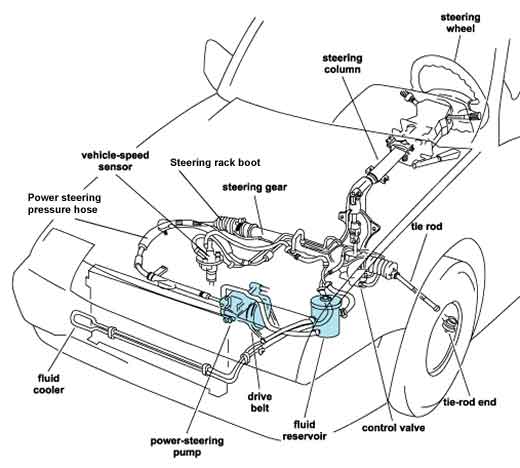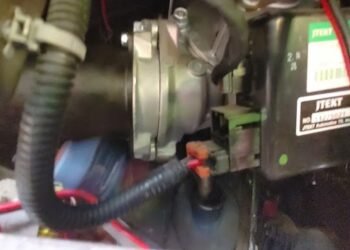Power steering fluid leaks can cause serious issues for your vehicle. They might seem minor, but ignoring them can lead to bigger problems.
A power steering fluid leak can make your car hard to control. This fluid is crucial for easy steering. Without it, you might hear strange noises and find it harder to turn the wheel. Identifying and fixing these leaks quickly is essential.
This blog will explain the common causes of power steering fluid leaks, how to spot them, and what you can do to fix them. Understanding these points will help you maintain your vehicle and ensure a smooth driving experience. Let’s dive into the details and keep your car running smoothly.
Signs Of A Power Steering Fluid Leak
Noticing signs of a power steering fluid leak early can save you from costly repairs. Leaks in the power steering system can lead to serious problems. Pay attention to these common signs to catch a leak before it worsens.
Unusual Noises
Strange sounds can be an early sign of a power steering fluid leak. If you hear a whining or groaning noise when turning the wheel, it could mean the fluid is low. These noises often get louder as you continue to drive. Always take unusual sounds seriously.
Difficulty Steering
Steering should be smooth and easy. If it becomes stiff or hard to turn, check your power steering fluid. Difficulty steering is a clear sign there might be a leak. Low fluid levels make steering more challenging and unsafe. Don’t ignore steering issues.
Puddles Under The Car
Leaks often leave visible signs. Look for puddles under your car after it’s been parked. Power steering fluid is usually reddish or light brown. Finding a puddle can help you identify a leak quickly. Always investigate any fluid under your vehicle.
Low Fluid Levels
Regularly check your power steering fluid levels. Low levels can indicate a slow leak. The reservoir should stay full if the system is working properly. If you need to refill it often, there’s likely a leak. Keeping the fluid at the right level is crucial for safe driving.

Credit: www.amazon.com
Common Causes Of Power Steering Fluid Leaks
Power steering fluid leaks can affect the performance of your vehicle. Understanding the common causes can help you address the problem quickly. Below are the most frequent reasons for power steering fluid leaks.
Worn Seals
Worn seals are a typical cause of power steering fluid leaks. Over time, seals can deteriorate due to wear and tear. This results in cracks or breaks. These worn seals fail to hold the fluid, leading to leaks. Regular maintenance and inspections can help identify worn seals early.
Damaged Hoses
Damaged hoses are another common culprit. Hoses can become brittle and crack over time. This is often due to exposure to high temperatures and pressure. A damaged hose will leak fluid, which can affect steering performance. Always check hoses for signs of wear and replace them when needed.
Faulty Pump
A faulty pump can also lead to power steering fluid leaks. The pump circulates the fluid through the system. If the pump fails, it can cause leaks at the connections. Listen for unusual noises from the pump, such as whining or grinding sounds. These can indicate a failing pump.
Cracked Reservoir
A cracked reservoir is another potential source of leaks. The reservoir holds the power steering fluid. If it develops cracks, fluid can leak out. Inspect the reservoir for any visible cracks or damage. Replacing a cracked reservoir can prevent further leaks.
Tools Needed For Repair
Experiencing a power steering fluid leak can be frustrating. Fixing it yourself is possible with the right tools. Here’s a detailed guide on the tools needed for repair. This will help you get the job done efficiently and safely.
Basic Hand Tools
You’ll need some basic hand tools to repair a power steering fluid leak. These include:
- Wrenches: Essential for loosening and tightening bolts.
- Screwdrivers: Useful for removing clamps and small screws.
- Pliers: Handy for gripping and manipulating parts.
- Socket Set: Required for various nuts and bolts sizes.
Replacement Parts
It’s crucial to have the right replacement parts on hand. These might include:
- Power Steering Hoses: Often the source of the leak.
- Seals and O-Rings: These prevent fluid from escaping.
- Power Steering Pump: Sometimes, the pump may need replacement.
Fluid Catch Pan
A fluid catch pan is essential for containing the leaking power steering fluid. It helps keep your workspace clean and prevents spills. Place the pan under the car to catch any fluid that drips out during the repair process.
Shop Rags
Shop rags are a must-have for any repair job. Use them to:
- Wipe up spilled fluid.
- Clean parts before reassembly.
- Dry off tools after use.
Keep plenty of shop rags nearby for a smooth and clean repair process.
How To Locate The Leak
Identify a power steering fluid leak by checking under the car for wet spots. Examine the hoses and connections for signs of dripping fluid.
Locating a power steering fluid leak early can save you from costly repairs. This section will guide you through the steps to find the source of the leak. By following these steps, you can ensure your vehicle’s power steering system remains in good condition.Visual Inspection
Start by checking the ground under your car. Look for any wet spots or puddles. These could be signs of a fluid leak. Next, open the hood and inspect the power steering reservoir. See if the fluid level is low. Leaks often leave a trail. Follow any wet areas or stains on the engine and undercarriage.Using Uv Dye
UV dye can help you locate hard-to-see leaks. Add the dye to the power steering fluid. Run the engine for a few minutes. Use a UV light to inspect the system. The dye will glow under UV light, highlighting the leak’s location. This method is very effective and easy to use.Checking Common Leak Points
Certain areas are more prone to leaks. Inspect the power steering pump. Look closely at the seals and hoses. Check the power steering rack and pinion for any signs of fluid. Also, inspect the hose connections and clamps. These parts often wear out and cause leaks. By following these steps, you can quickly find and fix power steering fluid leaks. This will help maintain your vehicle’s performance and safety.Temporary Fixes
Experiencing a power steering fluid leak can be a hassle. It’s important to address it promptly to avoid further damage. While a permanent fix is ideal, sometimes you need a temporary solution. Here are some effective temporary fixes you can try:
Using Stop Leak Products
Stop leak products are designed to seal small leaks in the power steering system. They are easy to use and can provide a quick fix. Here’s how:
- Buy a stop leak product suitable for power steering systems.
- Read the product instructions carefully.
- Pour the stop leak solution into the power steering reservoir.
- Start your car and turn the steering wheel from lock to lock.
- Drive the car for a short distance to allow the product to circulate.
These products can be effective for small leaks. They are not a permanent solution. Monitor the fluid level regularly.
Adding Fluid Regularly
If the leak is not severe, you can manage it by adding fluid regularly. This ensures your power steering system functions smoothly. Follow these steps:
- Check the power steering fluid level often.
- Keep a bottle of the recommended power steering fluid in your car.
- Top up the fluid when it gets low.
Frequent top-ups can keep your power steering system running. It’s a temporary fix. Plan for a permanent repair soon.

Credit: www.autotechiq.com
Permanent Repair Solutions
Experiencing a power steering fluid leak can be frustrating and potentially dangerous. To ensure your vehicle remains safe and functional, opting for permanent repair solutions is essential. Below, we explore the most effective methods to permanently fix a power steering fluid leak.
Replacing Damaged Hoses
Damaged hoses are a common cause of power steering fluid leaks. Over time, hoses can become brittle, cracked, or worn out. Replacing damaged hoses involves:
- Identifying the damaged hose
- Draining the power steering fluid
- Removing the old hose
- Installing a new, high-quality hose
- Refilling the power steering fluid
Always use hoses that match your vehicle’s specifications. This ensures a proper fit and long-lasting repair.
Fixing The Pump
The power steering pump is crucial for maintaining steering ease. Leaks from the pump can result from worn-out seals or bearings. Fixing the pump may require:
- Inspecting the pump for leaks
- Replacing worn-out seals
- Checking and replacing damaged bearings
- Reassembling the pump and testing for leaks
If the pump is severely damaged, consider a complete replacement for a permanent solution.
Repairing The Reservoir
The power steering fluid reservoir stores the fluid required for the system. A cracked or damaged reservoir can cause significant leaks. To repair the reservoir:
- Locate the crack or damage
- Drain the power steering fluid
- Remove the damaged reservoir
- Install a new reservoir
- Refill the system with fresh fluid
Ensuring the reservoir is intact prevents future leaks and maintains the system’s efficiency.
Preventing Future Leaks
Preventing power steering fluid leaks saves money and keeps your car safe. Regular care ensures your power steering system runs well. Small steps can stop big problems from happening.
Regular Maintenance
Regular maintenance is the key to a healthy power steering system. Check fluid levels often. Top up if it’s low. Change the fluid as your car’s manual suggests. This keeps the system clean and reduces wear.
Inspecting Components
Inspecting components helps catch problems early. Check hoses and seals for signs of wear. Look for cracks, leaks, or loose connections. Replace any damaged parts right away. This keeps your system tight and leak-free.
Using Quality Fluid
Using quality fluid makes a big difference. Cheap fluids can damage seals and hoses. Always use the fluid recommended by your car’s manufacturer. This ensures compatibility and protects your system. Quality fluid also lasts longer, saving you money.
When To Seek Professional Help
Dealing with a power steering fluid leak can be tricky. Some problems require expert hands. Knowing when to seek professional help is important for safety and preventing further damage.
Complex Repairs
Some leaks need intricate repairs. These can involve replacing hoses or seals. Such tasks need specialized tools and skills. Attempting these without experience can worsen the problem. Professionals know the exact steps and have the right equipment.
Recurring Issues
If leaks keep coming back, it’s a sign of a deeper issue. Maybe the problem is with the steering rack or pump. These parts are essential for safe driving. Persistent leaks may need a thorough inspection. Experts can diagnose and fix hidden faults.
Lack Of Tools Or Experience
Fixing a power steering leak requires proper tools. Many people do not have these at home. Expertise is another key factor. Handling the repairs without knowledge can be risky. Professionals have both tools and experience to ensure the job is done right.

Credit: www.goldeagle.com
Frequently Asked Questions
What Causes Power Steering Fluid Leaks?
Power steering fluid leaks often occur due to damaged hoses, seals, or a failing pump.
How Do I Identify A Power Steering Fluid Leak?
Look for red or pink fluid under your vehicle. Check the power steering reservoir.
Can I Drive With A Power Steering Fluid Leak?
It’s risky to drive with a power steering fluid leak. Steering can become hard, causing accidents.
How Do I Fix A Power Steering Fluid Leak?
Fixing a leak involves replacing damaged hoses, seals, or the power steering pump. Seek a mechanic’s help.
How Much Does It Cost To Repair A Power Steering Fluid Leak?
Repair costs vary. It can range from $100 to $500, depending on the damage.
Conclusion
A power steering fluid leak can cause serious problems. Regular checks are vital. Keep an eye out for warning signs. Address issues early to avoid costly repairs. Use this guide to understand and fix leaks. Your car’s health depends on it.
Stay safe and enjoy smooth driving. Taking care of your vehicle ensures longevity. Always consult a professional for major issues. Happy driving!
















